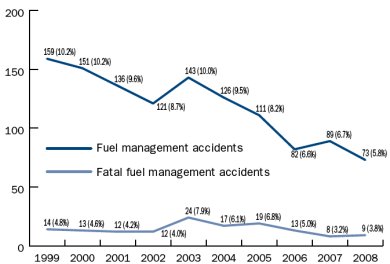|
One of the silliest, most preventable reasons for a small airplane to crash is
running out of gas. It happens with some frequency. Why?
Plane design doesn't help. Old airplanes typically have a float fuel gauge whose only standard of accuracy is "reads correct when empty". It's not uncommon for the gauge to read 5-10 gallons wrong. So before every flight I climb up to the wing and put a calibrated dipstick in the tank. And many airplanes require the pilot remembers to manually switch tanks or activate pumps in flight. Some 30% of fuel management accidents have the plane running out of gas while there's still gas in the tank. The primary way GA pilots manage fuel on board is to do arithmetic. You look at the length of your trip, the winds, read some performance charts, then bust out your calculator to figure out how long it will take you to get to your destination at what fuel burn. I might get anywhere from 10 to 18 miles per gallon on a flight. And if the headwind is stronger than I expected or I'm routed the long way, it might take more than that. The 30 minute required reserve is really not enough.
Fortunately the fuel accident trend has been improving. There were twice as many fuel management accidents ten years ago. Part of the improvement is education, part is technology. Aviation GPSes do a good job of estimating and displaying your range with available fuel. And fuel totalizers can very accurately measure how much fuel you've consumed. Still you have to know how much gas you had in the first place, a remarkably difficult thing to determine. |
||

